Operations & Project Management: Tesco's Implementation Critique
VerifiedAdded on 2023/06/07
|16
|5564
|238
Report
AI Summary
This report provides a comprehensive review and critique of operations management principles within Tesco. It begins with an introduction to Tesco, explaining the difference between operation and operations management. The report analyzes the implementation of operations management principles, examining how Tesco meets organizational requirements through its operations management. It discusses continuous improvement as a philosophy, detailing Lean principles and providing a continuous improvement plan with justified recommendations. The analysis covers Tesco's strategies for maintaining product quality, managing supply chains, and addressing competition, highlighting the importance of operational efficiency in achieving market leadership and customer satisfaction. The report concludes with a discussion of how operations management helps Tesco meet customer demands and maintain a competitive edge.
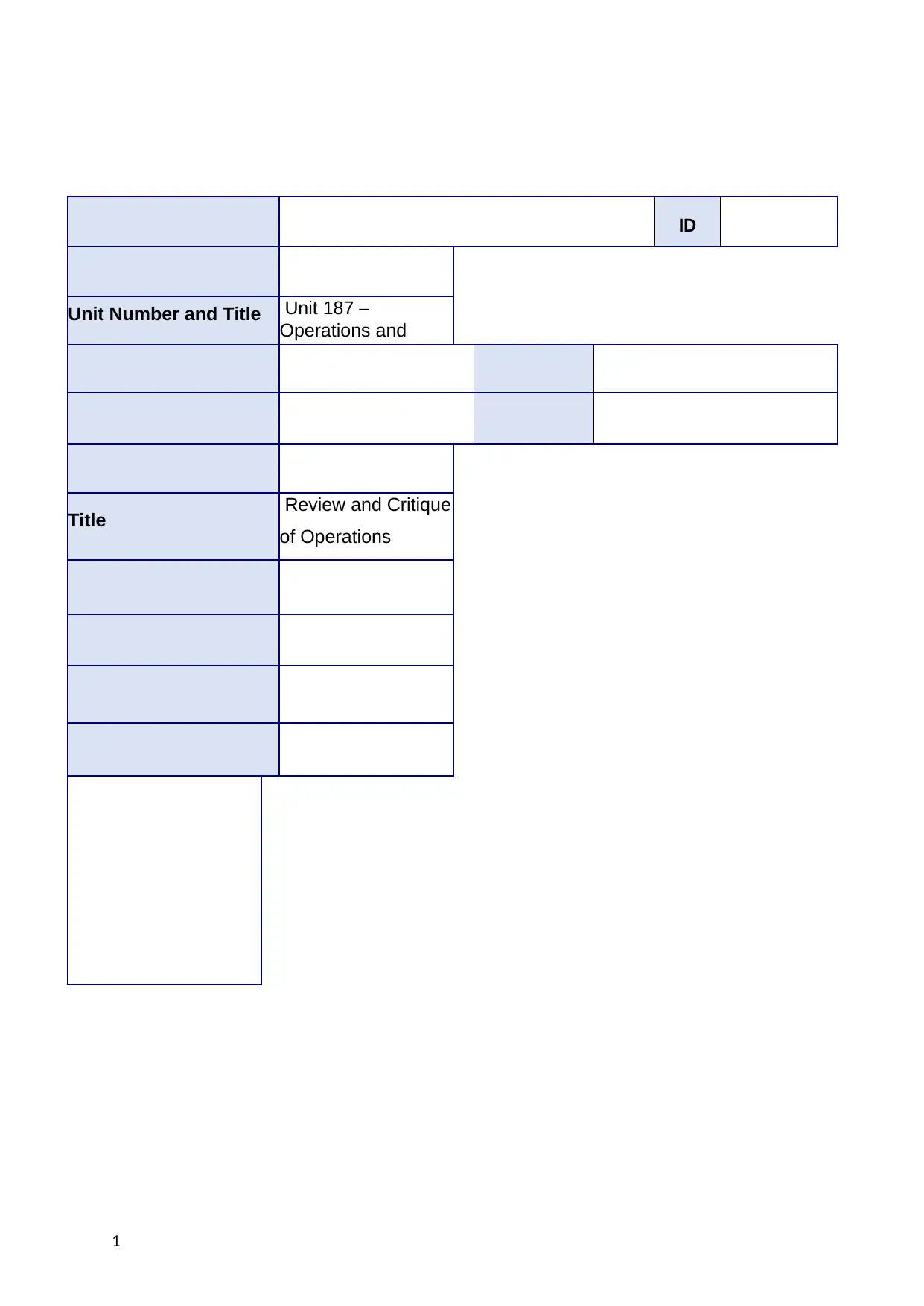
ID
Unit Number and Title Unit 187 –
Operations and
Project Management
Title Review and Critique
of Operations
Management (Part
1
Unit Number and Title Unit 187 –
Operations and
Project Management
Title Review and Critique
of Operations
Management (Part
1
Paraphrase This Document
Need a fresh take? Get an instant paraphrase of this document with our AI Paraphraser
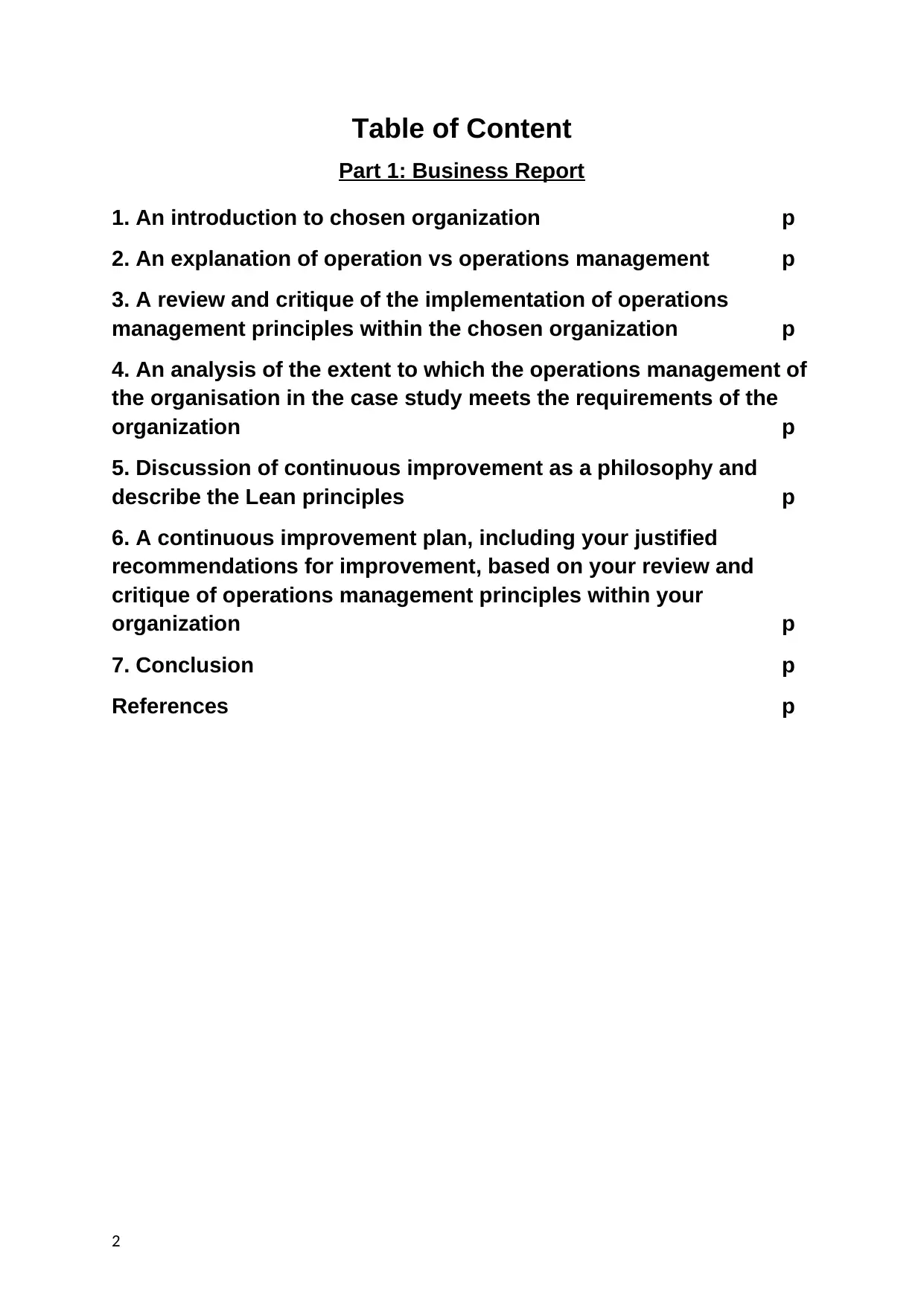
Table of Content
Part 1: Business Report
1. An introduction to chosen organization p
2. An explanation of operation vs operations management p
3. A review and critique of the implementation of operations
management principles within the chosen organization p
4. An analysis of the extent to which the operations management of
the organisation in the case study meets the requirements of the
organization p
5. Discussion of continuous improvement as a philosophy and
describe the Lean principles p
6. A continuous improvement plan, including your justified
recommendations for improvement, based on your review and
critique of operations management principles within your
organization p
7. Conclusion p
References p
2
Part 1: Business Report
1. An introduction to chosen organization p
2. An explanation of operation vs operations management p
3. A review and critique of the implementation of operations
management principles within the chosen organization p
4. An analysis of the extent to which the operations management of
the organisation in the case study meets the requirements of the
organization p
5. Discussion of continuous improvement as a philosophy and
describe the Lean principles p
6. A continuous improvement plan, including your justified
recommendations for improvement, based on your review and
critique of operations management principles within your
organization p
7. Conclusion p
References p
2
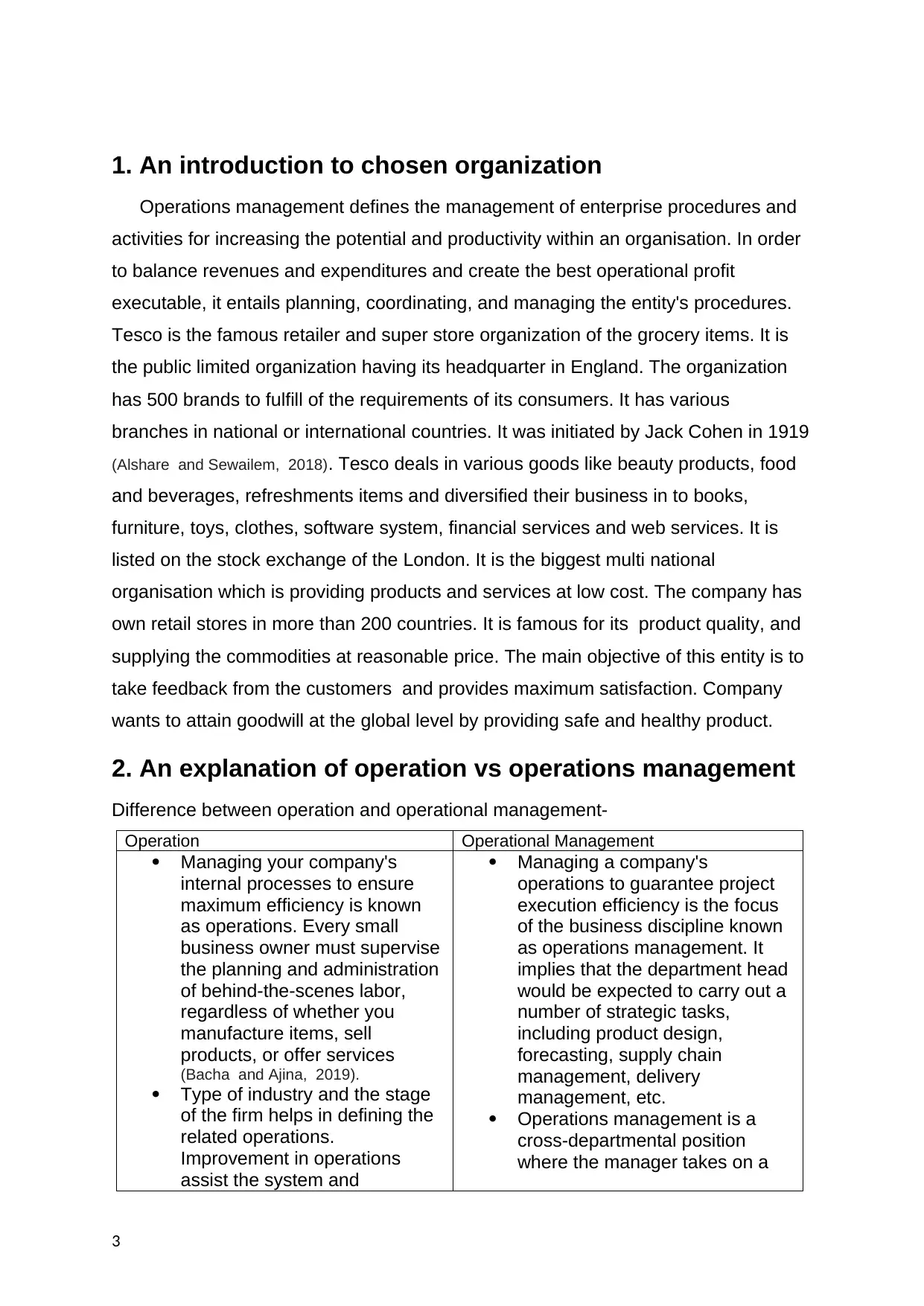
1. An introduction to chosen organization
Operations management defines the management of enterprise procedures and
activities for increasing the potential and productivity within an organisation. In order
to balance revenues and expenditures and create the best operational profit
executable, it entails planning, coordinating, and managing the entity's procedures.
Tesco is the famous retailer and super store organization of the grocery items. It is
the public limited organization having its headquarter in England. The organization
has 500 brands to fulfill of the requirements of its consumers. It has various
branches in national or international countries. It was initiated by Jack Cohen in 1919
(Alshare and Sewailem, 2018). Tesco deals in various goods like beauty products, food
and beverages, refreshments items and diversified their business in to books,
furniture, toys, clothes, software system, financial services and web services. It is
listed on the stock exchange of the London. It is the biggest multi national
organisation which is providing products and services at low cost. The company has
own retail stores in more than 200 countries. It is famous for its product quality, and
supplying the commodities at reasonable price. The main objective of this entity is to
take feedback from the customers and provides maximum satisfaction. Company
wants to attain goodwill at the global level by providing safe and healthy product.
2. An explanation of operation vs operations management
Difference between operation and operational management-
Operation Operational Management
Managing your company's
internal processes to ensure
maximum efficiency is known
as operations. Every small
business owner must supervise
the planning and administration
of behind-the-scenes labor,
regardless of whether you
manufacture items, sell
products, or offer services
(Bacha and Ajina, 2019).
Type of industry and the stage
of the firm helps in defining the
related operations.
Improvement in operations
assist the system and
Managing a company's
operations to guarantee project
execution efficiency is the focus
of the business discipline known
as operations management. It
implies that the department head
would be expected to carry out a
number of strategic tasks,
including product design,
forecasting, supply chain
management, delivery
management, etc.
Operations management is a
cross-departmental position
where the manager takes on a
3
Operations management defines the management of enterprise procedures and
activities for increasing the potential and productivity within an organisation. In order
to balance revenues and expenditures and create the best operational profit
executable, it entails planning, coordinating, and managing the entity's procedures.
Tesco is the famous retailer and super store organization of the grocery items. It is
the public limited organization having its headquarter in England. The organization
has 500 brands to fulfill of the requirements of its consumers. It has various
branches in national or international countries. It was initiated by Jack Cohen in 1919
(Alshare and Sewailem, 2018). Tesco deals in various goods like beauty products, food
and beverages, refreshments items and diversified their business in to books,
furniture, toys, clothes, software system, financial services and web services. It is
listed on the stock exchange of the London. It is the biggest multi national
organisation which is providing products and services at low cost. The company has
own retail stores in more than 200 countries. It is famous for its product quality, and
supplying the commodities at reasonable price. The main objective of this entity is to
take feedback from the customers and provides maximum satisfaction. Company
wants to attain goodwill at the global level by providing safe and healthy product.
2. An explanation of operation vs operations management
Difference between operation and operational management-
Operation Operational Management
Managing your company's
internal processes to ensure
maximum efficiency is known
as operations. Every small
business owner must supervise
the planning and administration
of behind-the-scenes labor,
regardless of whether you
manufacture items, sell
products, or offer services
(Bacha and Ajina, 2019).
Type of industry and the stage
of the firm helps in defining the
related operations.
Improvement in operations
assist the system and
Managing a company's
operations to guarantee project
execution efficiency is the focus
of the business discipline known
as operations management. It
implies that the department head
would be expected to carry out a
number of strategic tasks,
including product design,
forecasting, supply chain
management, delivery
management, etc.
Operations management is a
cross-departmental position
where the manager takes on a
3
⊘ This is a preview!⊘
Do you want full access?
Subscribe today to unlock all pages.

Trusted by 1+ million students worldwide
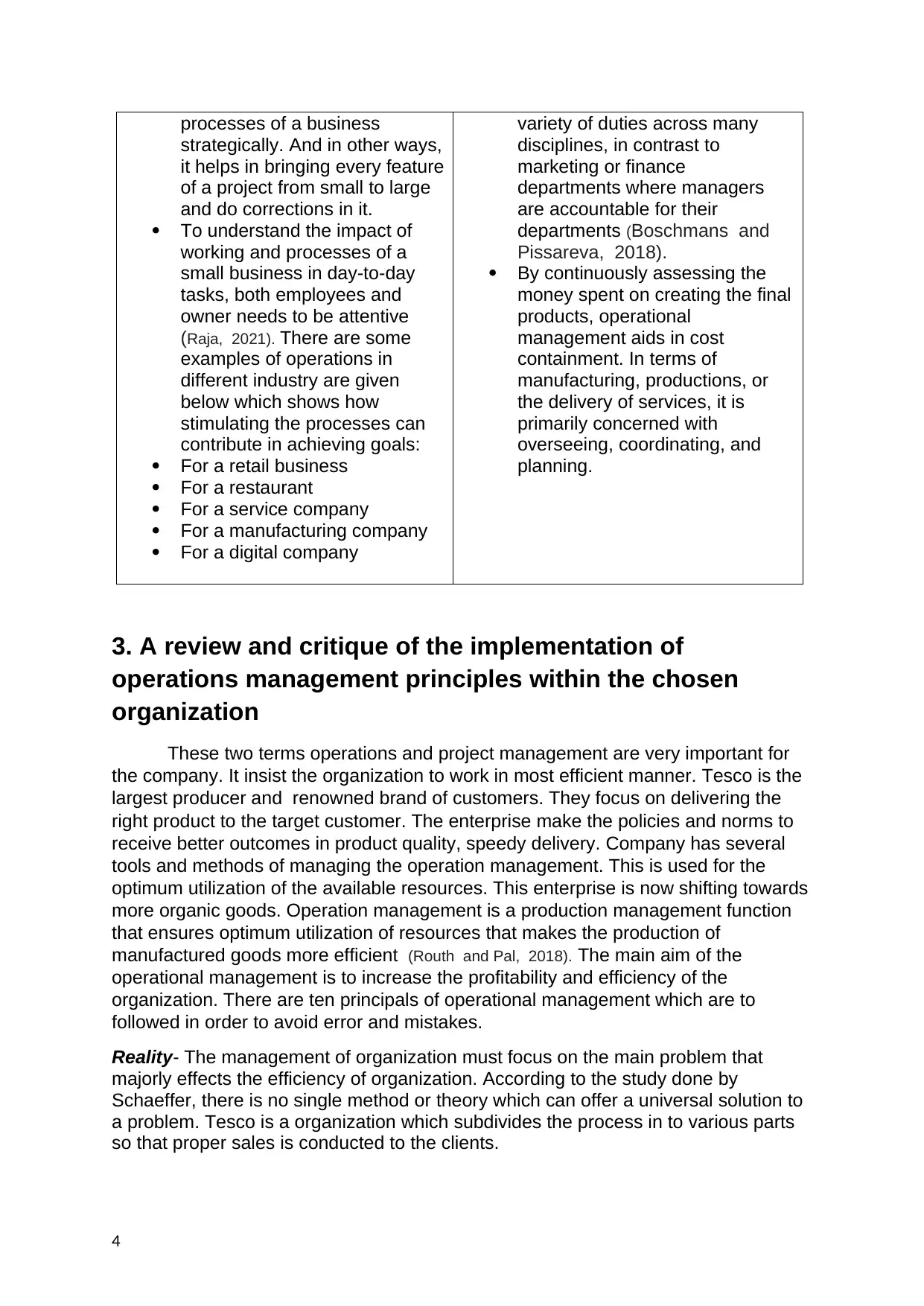
processes of a business
strategically. And in other ways,
it helps in bringing every feature
of a project from small to large
and do corrections in it.
To understand the impact of
working and processes of a
small business in day-to-day
tasks, both employees and
owner needs to be attentive
(Raja, 2021). There are some
examples of operations in
different industry are given
below which shows how
stimulating the processes can
contribute in achieving goals:
For a retail business
For a restaurant
For a service company
For a manufacturing company
For a digital company
variety of duties across many
disciplines, in contrast to
marketing or finance
departments where managers
are accountable for their
departments (Boschmans and
Pissareva, 2018).
By continuously assessing the
money spent on creating the final
products, operational
management aids in cost
containment. In terms of
manufacturing, productions, or
the delivery of services, it is
primarily concerned with
overseeing, coordinating, and
planning.
3. A review and critique of the implementation of
operations management principles within the chosen
organization
These two terms operations and project management are very important for
the company. It insist the organization to work in most efficient manner. Tesco is the
largest producer and renowned brand of customers. They focus on delivering the
right product to the target customer. The enterprise make the policies and norms to
receive better outcomes in product quality, speedy delivery. Company has several
tools and methods of managing the operation management. This is used for the
optimum utilization of the available resources. This enterprise is now shifting towards
more organic goods. Operation management is a production management function
that ensures optimum utilization of resources that makes the production of
manufactured goods more efficient (Routh and Pal, 2018). The main aim of the
operational management is to increase the profitability and efficiency of the
organization. There are ten principals of operational management which are to
followed in order to avoid error and mistakes.
Reality- The management of organization must focus on the main problem that
majorly effects the efficiency of organization. According to the study done by
Schaeffer, there is no single method or theory which can offer a universal solution to
a problem. Tesco is a organization which subdivides the process in to various parts
so that proper sales is conducted to the clients.
4
strategically. And in other ways,
it helps in bringing every feature
of a project from small to large
and do corrections in it.
To understand the impact of
working and processes of a
small business in day-to-day
tasks, both employees and
owner needs to be attentive
(Raja, 2021). There are some
examples of operations in
different industry are given
below which shows how
stimulating the processes can
contribute in achieving goals:
For a retail business
For a restaurant
For a service company
For a manufacturing company
For a digital company
variety of duties across many
disciplines, in contrast to
marketing or finance
departments where managers
are accountable for their
departments (Boschmans and
Pissareva, 2018).
By continuously assessing the
money spent on creating the final
products, operational
management aids in cost
containment. In terms of
manufacturing, productions, or
the delivery of services, it is
primarily concerned with
overseeing, coordinating, and
planning.
3. A review and critique of the implementation of
operations management principles within the chosen
organization
These two terms operations and project management are very important for
the company. It insist the organization to work in most efficient manner. Tesco is the
largest producer and renowned brand of customers. They focus on delivering the
right product to the target customer. The enterprise make the policies and norms to
receive better outcomes in product quality, speedy delivery. Company has several
tools and methods of managing the operation management. This is used for the
optimum utilization of the available resources. This enterprise is now shifting towards
more organic goods. Operation management is a production management function
that ensures optimum utilization of resources that makes the production of
manufactured goods more efficient (Routh and Pal, 2018). The main aim of the
operational management is to increase the profitability and efficiency of the
organization. There are ten principals of operational management which are to
followed in order to avoid error and mistakes.
Reality- The management of organization must focus on the main problem that
majorly effects the efficiency of organization. According to the study done by
Schaeffer, there is no single method or theory which can offer a universal solution to
a problem. Tesco is a organization which subdivides the process in to various parts
so that proper sales is conducted to the clients.
4
Paraphrase This Document
Need a fresh take? Get an instant paraphrase of this document with our AI Paraphraser
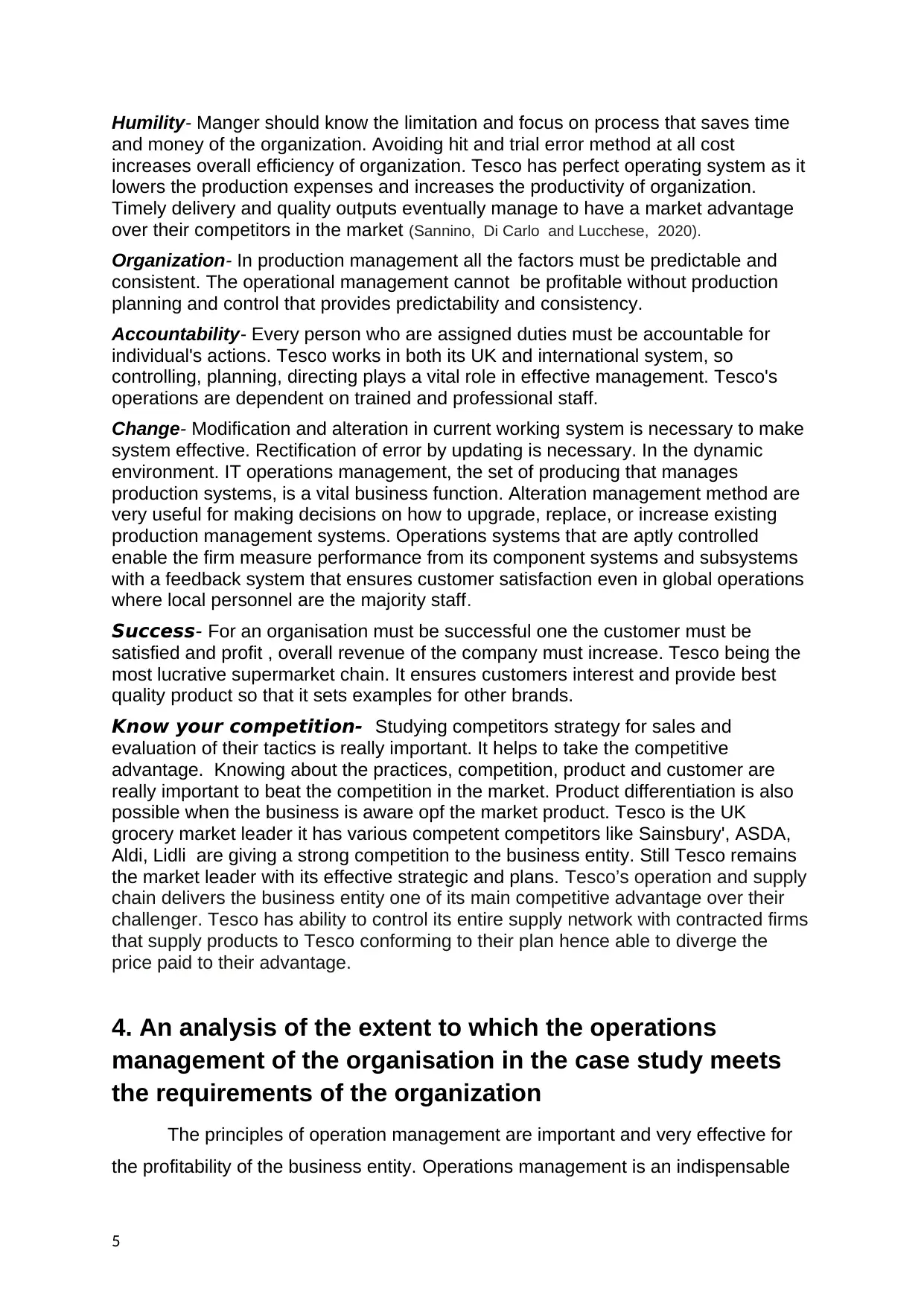
Humility- Manger should know the limitation and focus on process that saves time
and money of the organization. Avoiding hit and trial error method at all cost
increases overall efficiency of organization. Tesco has perfect operating system as it
lowers the production expenses and increases the productivity of organization.
Timely delivery and quality outputs eventually manage to have a market advantage
over their competitors in the market (Sannino, Di Carlo and Lucchese, 2020).
Organization- In production management all the factors must be predictable and
consistent. The operational management cannot be profitable without production
planning and control that provides predictability and consistency.
Accountability- Every person who are assigned duties must be accountable for
individual's actions. Tesco works in both its UK and international system, so
controlling, planning, directing plays a vital role in effective management. Tesco's
operations are dependent on trained and professional staff.
Change- Modification and alteration in current working system is necessary to make
system effective. Rectification of error by updating is necessary. In the dynamic
environment. IT operations management, the set of producing that manages
production systems, is a vital business function. Alteration management method are
very useful for making decisions on how to upgrade, replace, or increase existing
production management systems. Operations systems that are aptly controlled
enable the firm measure performance from its component systems and subsystems
with a feedback system that ensures customer satisfaction even in global operations
where local personnel are the majority staff.
Success- For an organisation must be successful one the customer must be
satisfied and profit , overall revenue of the company must increase. Tesco being the
most lucrative supermarket chain. It ensures customers interest and provide best
quality product so that it sets examples for other brands.
Know your competition- Studying competitors strategy for sales and
evaluation of their tactics is really important. It helps to take the competitive
advantage. Knowing about the practices, competition, product and customer are
really important to beat the competition in the market. Product differentiation is also
possible when the business is aware opf the market product. Tesco is the UK
grocery market leader it has various competent competitors like Sainsbury', ASDA,
Aldi, Lidli are giving a strong competition to the business entity. Still Tesco remains
the market leader with its effective strategic and plans. Tesco’s operation and supply
chain delivers the business entity one of its main competitive advantage over their
challenger. Tesco has ability to control its entire supply network with contracted firms
that supply products to Tesco conforming to their plan hence able to diverge the
price paid to their advantage.
4. An analysis of the extent to which the operations
management of the organisation in the case study meets
the requirements of the organization
The principles of operation management are important and very effective for
the profitability of the business entity. Operations management is an indispensable
5
and money of the organization. Avoiding hit and trial error method at all cost
increases overall efficiency of organization. Tesco has perfect operating system as it
lowers the production expenses and increases the productivity of organization.
Timely delivery and quality outputs eventually manage to have a market advantage
over their competitors in the market (Sannino, Di Carlo and Lucchese, 2020).
Organization- In production management all the factors must be predictable and
consistent. The operational management cannot be profitable without production
planning and control that provides predictability and consistency.
Accountability- Every person who are assigned duties must be accountable for
individual's actions. Tesco works in both its UK and international system, so
controlling, planning, directing plays a vital role in effective management. Tesco's
operations are dependent on trained and professional staff.
Change- Modification and alteration in current working system is necessary to make
system effective. Rectification of error by updating is necessary. In the dynamic
environment. IT operations management, the set of producing that manages
production systems, is a vital business function. Alteration management method are
very useful for making decisions on how to upgrade, replace, or increase existing
production management systems. Operations systems that are aptly controlled
enable the firm measure performance from its component systems and subsystems
with a feedback system that ensures customer satisfaction even in global operations
where local personnel are the majority staff.
Success- For an organisation must be successful one the customer must be
satisfied and profit , overall revenue of the company must increase. Tesco being the
most lucrative supermarket chain. It ensures customers interest and provide best
quality product so that it sets examples for other brands.
Know your competition- Studying competitors strategy for sales and
evaluation of their tactics is really important. It helps to take the competitive
advantage. Knowing about the practices, competition, product and customer are
really important to beat the competition in the market. Product differentiation is also
possible when the business is aware opf the market product. Tesco is the UK
grocery market leader it has various competent competitors like Sainsbury', ASDA,
Aldi, Lidli are giving a strong competition to the business entity. Still Tesco remains
the market leader with its effective strategic and plans. Tesco’s operation and supply
chain delivers the business entity one of its main competitive advantage over their
challenger. Tesco has ability to control its entire supply network with contracted firms
that supply products to Tesco conforming to their plan hence able to diverge the
price paid to their advantage.
4. An analysis of the extent to which the operations
management of the organisation in the case study meets
the requirements of the organization
The principles of operation management are important and very effective for
the profitability of the business entity. Operations management is an indispensable
5
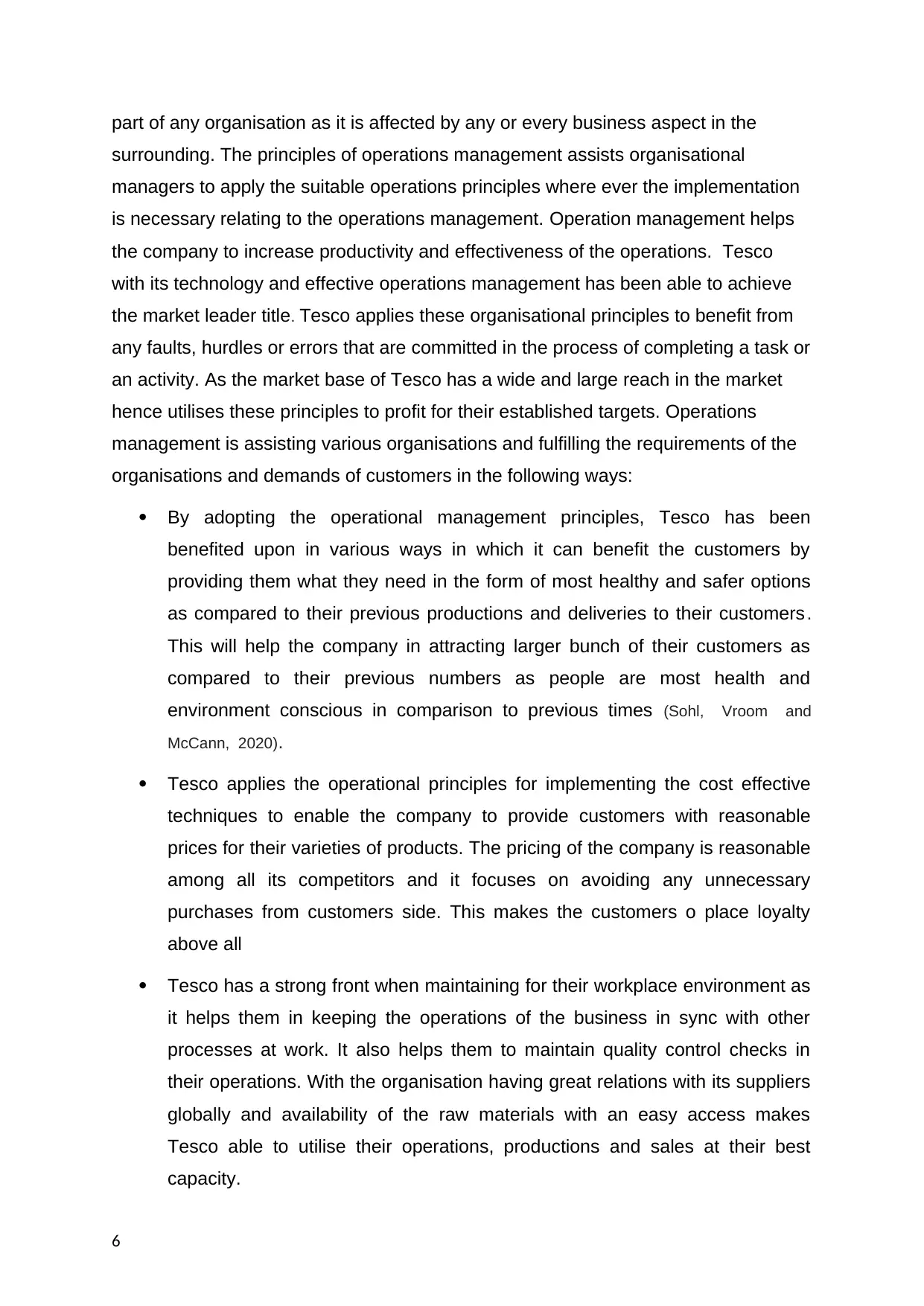
part of any organisation as it is affected by any or every business aspect in the
surrounding. The principles of operations management assists organisational
managers to apply the suitable operations principles where ever the implementation
is necessary relating to the operations management. Operation management helps
the company to increase productivity and effectiveness of the operations. Tesco
with its technology and effective operations management has been able to achieve
the market leader title. Tesco applies these organisational principles to benefit from
any faults, hurdles or errors that are committed in the process of completing a task or
an activity. As the market base of Tesco has a wide and large reach in the market
hence utilises these principles to profit for their established targets. Operations
management is assisting various organisations and fulfilling the requirements of the
organisations and demands of customers in the following ways:
By adopting the operational management principles, Tesco has been
benefited upon in various ways in which it can benefit the customers by
providing them what they need in the form of most healthy and safer options
as compared to their previous productions and deliveries to their customers.
This will help the company in attracting larger bunch of their customers as
compared to their previous numbers as people are most health and
environment conscious in comparison to previous times (Sohl, Vroom and
McCann, 2020).
Tesco applies the operational principles for implementing the cost effective
techniques to enable the company to provide customers with reasonable
prices for their varieties of products. The pricing of the company is reasonable
among all its competitors and it focuses on avoiding any unnecessary
purchases from customers side. This makes the customers o place loyalty
above all
Tesco has a strong front when maintaining for their workplace environment as
it helps them in keeping the operations of the business in sync with other
processes at work. It also helps them to maintain quality control checks in
their operations. With the organisation having great relations with its suppliers
globally and availability of the raw materials with an easy access makes
Tesco able to utilise their operations, productions and sales at their best
capacity.
6
surrounding. The principles of operations management assists organisational
managers to apply the suitable operations principles where ever the implementation
is necessary relating to the operations management. Operation management helps
the company to increase productivity and effectiveness of the operations. Tesco
with its technology and effective operations management has been able to achieve
the market leader title. Tesco applies these organisational principles to benefit from
any faults, hurdles or errors that are committed in the process of completing a task or
an activity. As the market base of Tesco has a wide and large reach in the market
hence utilises these principles to profit for their established targets. Operations
management is assisting various organisations and fulfilling the requirements of the
organisations and demands of customers in the following ways:
By adopting the operational management principles, Tesco has been
benefited upon in various ways in which it can benefit the customers by
providing them what they need in the form of most healthy and safer options
as compared to their previous productions and deliveries to their customers.
This will help the company in attracting larger bunch of their customers as
compared to their previous numbers as people are most health and
environment conscious in comparison to previous times (Sohl, Vroom and
McCann, 2020).
Tesco applies the operational principles for implementing the cost effective
techniques to enable the company to provide customers with reasonable
prices for their varieties of products. The pricing of the company is reasonable
among all its competitors and it focuses on avoiding any unnecessary
purchases from customers side. This makes the customers o place loyalty
above all
Tesco has a strong front when maintaining for their workplace environment as
it helps them in keeping the operations of the business in sync with other
processes at work. It also helps them to maintain quality control checks in
their operations. With the organisation having great relations with its suppliers
globally and availability of the raw materials with an easy access makes
Tesco able to utilise their operations, productions and sales at their best
capacity.
6
⊘ This is a preview!⊘
Do you want full access?
Subscribe today to unlock all pages.

Trusted by 1+ million students worldwide
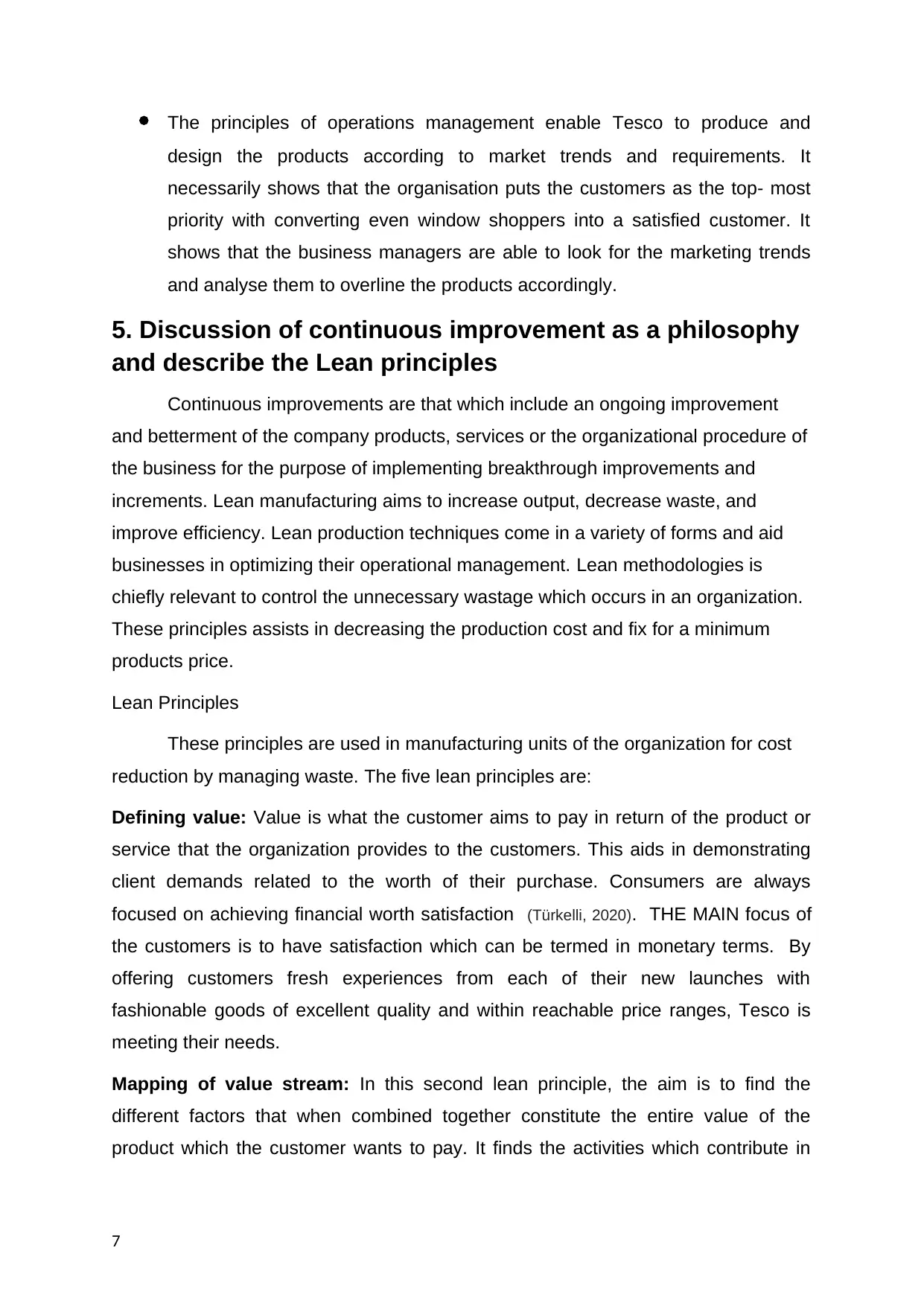
The principles of operations management enable Tesco to produce and
design the products according to market trends and requirements. It
necessarily shows that the organisation puts the customers as the top- most
priority with converting even window shoppers into a satisfied customer. It
shows that the business managers are able to look for the marketing trends
and analyse them to overline the products accordingly.
5. Discussion of continuous improvement as a philosophy
and describe the Lean principles
Continuous improvements are that which include an ongoing improvement
and betterment of the company products, services or the organizational procedure of
the business for the purpose of implementing breakthrough improvements and
increments. Lean manufacturing aims to increase output, decrease waste, and
improve efficiency. Lean production techniques come in a variety of forms and aid
businesses in optimizing their operational management. Lean methodologies is
chiefly relevant to control the unnecessary wastage which occurs in an organization.
These principles assists in decreasing the production cost and fix for a minimum
products price.
Lean Principles
These principles are used in manufacturing units of the organization for cost
reduction by managing waste. The five lean principles are:
Defining value: Value is what the customer aims to pay in return of the product or
service that the organization provides to the customers. This aids in demonstrating
client demands related to the worth of their purchase. Consumers are always
focused on achieving financial worth satisfaction (Türkelli, 2020). THE MAIN focus of
the customers is to have satisfaction which can be termed in monetary terms. By
offering customers fresh experiences from each of their new launches with
fashionable goods of excellent quality and within reachable price ranges, Tesco is
meeting their needs.
Mapping of value stream: In this second lean principle, the aim is to find the
different factors that when combined together constitute the entire value of the
product which the customer wants to pay. It finds the activities which contribute in
7
design the products according to market trends and requirements. It
necessarily shows that the organisation puts the customers as the top- most
priority with converting even window shoppers into a satisfied customer. It
shows that the business managers are able to look for the marketing trends
and analyse them to overline the products accordingly.
5. Discussion of continuous improvement as a philosophy
and describe the Lean principles
Continuous improvements are that which include an ongoing improvement
and betterment of the company products, services or the organizational procedure of
the business for the purpose of implementing breakthrough improvements and
increments. Lean manufacturing aims to increase output, decrease waste, and
improve efficiency. Lean production techniques come in a variety of forms and aid
businesses in optimizing their operational management. Lean methodologies is
chiefly relevant to control the unnecessary wastage which occurs in an organization.
These principles assists in decreasing the production cost and fix for a minimum
products price.
Lean Principles
These principles are used in manufacturing units of the organization for cost
reduction by managing waste. The five lean principles are:
Defining value: Value is what the customer aims to pay in return of the product or
service that the organization provides to the customers. This aids in demonstrating
client demands related to the worth of their purchase. Consumers are always
focused on achieving financial worth satisfaction (Türkelli, 2020). THE MAIN focus of
the customers is to have satisfaction which can be termed in monetary terms. By
offering customers fresh experiences from each of their new launches with
fashionable goods of excellent quality and within reachable price ranges, Tesco is
meeting their needs.
Mapping of value stream: In this second lean principle, the aim is to find the
different factors that when combined together constitute the entire value of the
product which the customer wants to pay. It finds the activities which contribute in
7
Paraphrase This Document
Need a fresh take? Get an instant paraphrase of this document with our AI Paraphraser
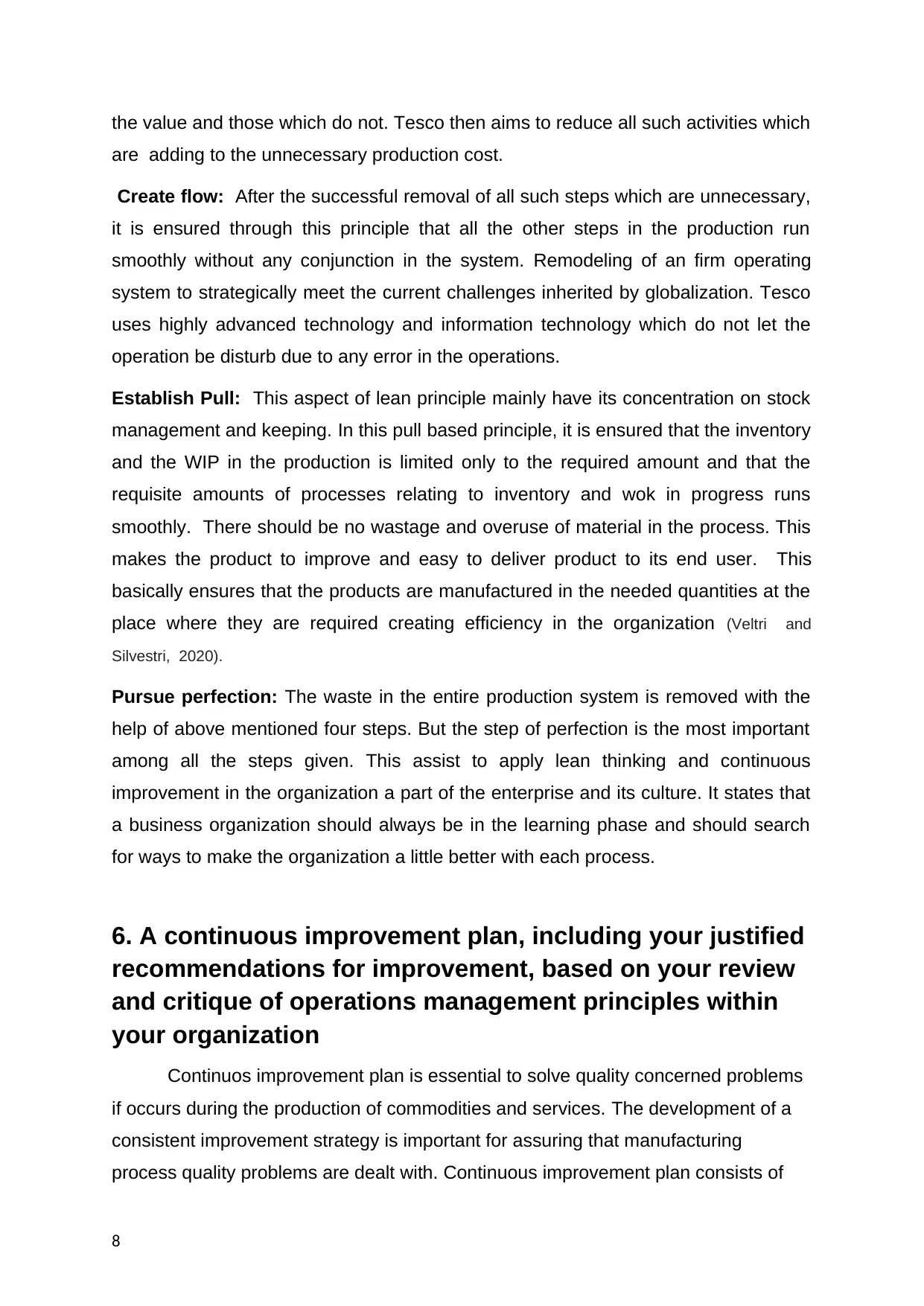
the value and those which do not. Tesco then aims to reduce all such activities which
are adding to the unnecessary production cost.
Create flow: After the successful removal of all such steps which are unnecessary,
it is ensured through this principle that all the other steps in the production run
smoothly without any conjunction in the system. Remodeling of an firm operating
system to strategically meet the current challenges inherited by globalization. Tesco
uses highly advanced technology and information technology which do not let the
operation be disturb due to any error in the operations.
Establish Pull: This aspect of lean principle mainly have its concentration on stock
management and keeping. In this pull based principle, it is ensured that the inventory
and the WIP in the production is limited only to the required amount and that the
requisite amounts of processes relating to inventory and wok in progress runs
smoothly. There should be no wastage and overuse of material in the process. This
makes the product to improve and easy to deliver product to its end user. This
basically ensures that the products are manufactured in the needed quantities at the
place where they are required creating efficiency in the organization (Veltri and
Silvestri, 2020).
Pursue perfection: The waste in the entire production system is removed with the
help of above mentioned four steps. But the step of perfection is the most important
among all the steps given. This assist to apply lean thinking and continuous
improvement in the organization a part of the enterprise and its culture. It states that
a business organization should always be in the learning phase and should search
for ways to make the organization a little better with each process.
6. A continuous improvement plan, including your justified
recommendations for improvement, based on your review
and critique of operations management principles within
your organization
Continuos improvement plan is essential to solve quality concerned problems
if occurs during the production of commodities and services. The development of a
consistent improvement strategy is important for assuring that manufacturing
process quality problems are dealt with. Continuous improvement plan consists of
8
are adding to the unnecessary production cost.
Create flow: After the successful removal of all such steps which are unnecessary,
it is ensured through this principle that all the other steps in the production run
smoothly without any conjunction in the system. Remodeling of an firm operating
system to strategically meet the current challenges inherited by globalization. Tesco
uses highly advanced technology and information technology which do not let the
operation be disturb due to any error in the operations.
Establish Pull: This aspect of lean principle mainly have its concentration on stock
management and keeping. In this pull based principle, it is ensured that the inventory
and the WIP in the production is limited only to the required amount and that the
requisite amounts of processes relating to inventory and wok in progress runs
smoothly. There should be no wastage and overuse of material in the process. This
makes the product to improve and easy to deliver product to its end user. This
basically ensures that the products are manufactured in the needed quantities at the
place where they are required creating efficiency in the organization (Veltri and
Silvestri, 2020).
Pursue perfection: The waste in the entire production system is removed with the
help of above mentioned four steps. But the step of perfection is the most important
among all the steps given. This assist to apply lean thinking and continuous
improvement in the organization a part of the enterprise and its culture. It states that
a business organization should always be in the learning phase and should search
for ways to make the organization a little better with each process.
6. A continuous improvement plan, including your justified
recommendations for improvement, based on your review
and critique of operations management principles within
your organization
Continuos improvement plan is essential to solve quality concerned problems
if occurs during the production of commodities and services. The development of a
consistent improvement strategy is important for assuring that manufacturing
process quality problems are dealt with. Continuous improvement plan consists of
8
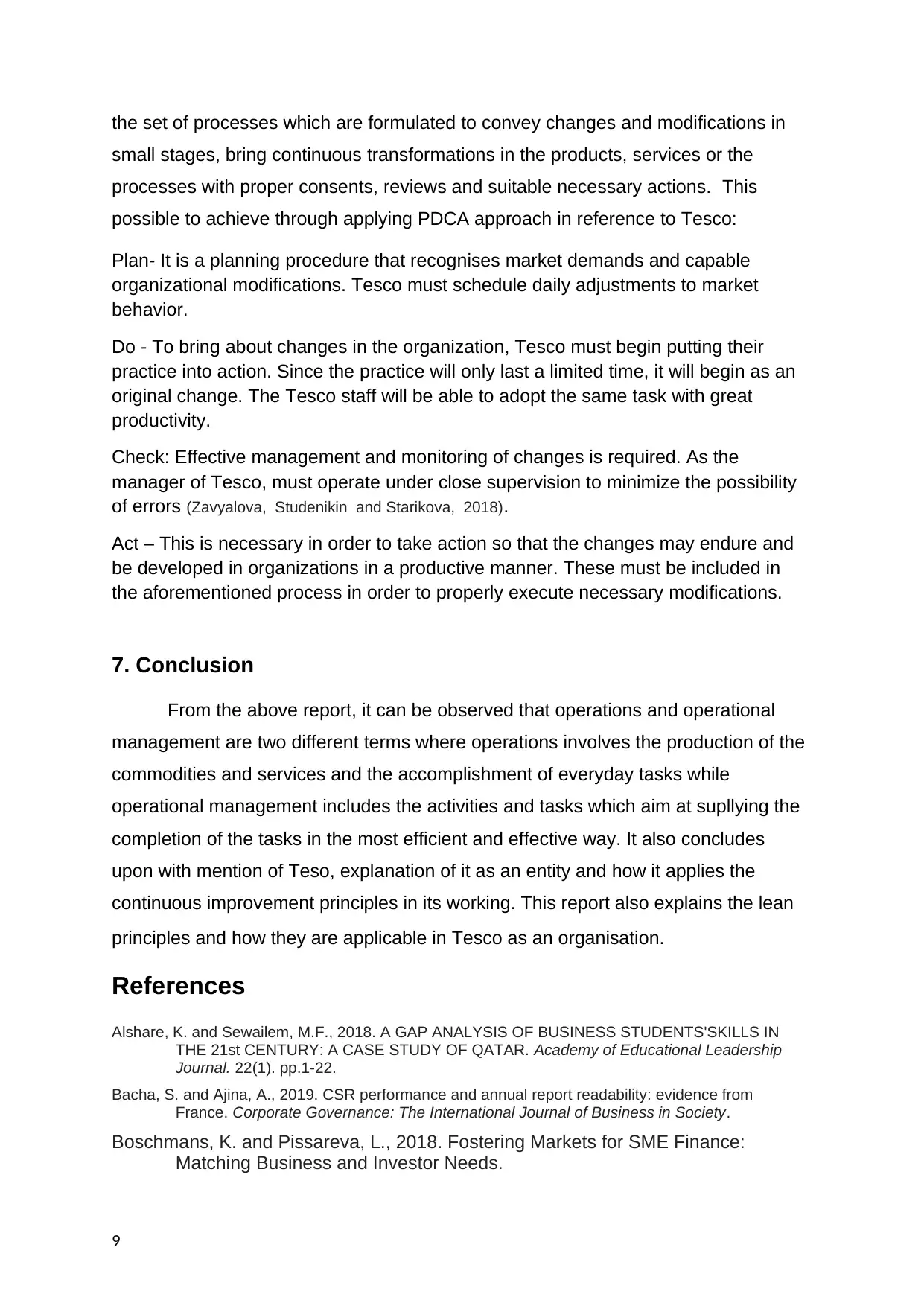
the set of processes which are formulated to convey changes and modifications in
small stages, bring continuous transformations in the products, services or the
processes with proper consents, reviews and suitable necessary actions. This
possible to achieve through applying PDCA approach in reference to Tesco:
Plan- It is a planning procedure that recognises market demands and capable
organizational modifications. Tesco must schedule daily adjustments to market
behavior.
Do - To bring about changes in the organization, Tesco must begin putting their
practice into action. Since the practice will only last a limited time, it will begin as an
original change. The Tesco staff will be able to adopt the same task with great
productivity.
Check: Effective management and monitoring of changes is required. As the
manager of Tesco, must operate under close supervision to minimize the possibility
of errors (Zavyalova, Studenikin and Starikova, 2018).
Act – This is necessary in order to take action so that the changes may endure and
be developed in organizations in a productive manner. These must be included in
the aforementioned process in order to properly execute necessary modifications.
7. Conclusion
From the above report, it can be observed that operations and operational
management are two different terms where operations involves the production of the
commodities and services and the accomplishment of everyday tasks while
operational management includes the activities and tasks which aim at supllying the
completion of the tasks in the most efficient and effective way. It also concludes
upon with mention of Teso, explanation of it as an entity and how it applies the
continuous improvement principles in its working. This report also explains the lean
principles and how they are applicable in Tesco as an organisation.
References
Alshare, K. and Sewailem, M.F., 2018. A GAP ANALYSIS OF BUSINESS STUDENTS'SKILLS IN
THE 21st CENTURY: A CASE STUDY OF QATAR. Academy of Educational Leadership
Journal. 22(1). pp.1-22.
Bacha, S. and Ajina, A., 2019. CSR performance and annual report readability: evidence from
France. Corporate Governance: The International Journal of Business in Society.
Boschmans, K. and Pissareva, L., 2018. Fostering Markets for SME Finance:
Matching Business and Investor Needs.
9
small stages, bring continuous transformations in the products, services or the
processes with proper consents, reviews and suitable necessary actions. This
possible to achieve through applying PDCA approach in reference to Tesco:
Plan- It is a planning procedure that recognises market demands and capable
organizational modifications. Tesco must schedule daily adjustments to market
behavior.
Do - To bring about changes in the organization, Tesco must begin putting their
practice into action. Since the practice will only last a limited time, it will begin as an
original change. The Tesco staff will be able to adopt the same task with great
productivity.
Check: Effective management and monitoring of changes is required. As the
manager of Tesco, must operate under close supervision to minimize the possibility
of errors (Zavyalova, Studenikin and Starikova, 2018).
Act – This is necessary in order to take action so that the changes may endure and
be developed in organizations in a productive manner. These must be included in
the aforementioned process in order to properly execute necessary modifications.
7. Conclusion
From the above report, it can be observed that operations and operational
management are two different terms where operations involves the production of the
commodities and services and the accomplishment of everyday tasks while
operational management includes the activities and tasks which aim at supllying the
completion of the tasks in the most efficient and effective way. It also concludes
upon with mention of Teso, explanation of it as an entity and how it applies the
continuous improvement principles in its working. This report also explains the lean
principles and how they are applicable in Tesco as an organisation.
References
Alshare, K. and Sewailem, M.F., 2018. A GAP ANALYSIS OF BUSINESS STUDENTS'SKILLS IN
THE 21st CENTURY: A CASE STUDY OF QATAR. Academy of Educational Leadership
Journal. 22(1). pp.1-22.
Bacha, S. and Ajina, A., 2019. CSR performance and annual report readability: evidence from
France. Corporate Governance: The International Journal of Business in Society.
Boschmans, K. and Pissareva, L., 2018. Fostering Markets for SME Finance:
Matching Business and Investor Needs.
9
⊘ This is a preview!⊘
Do you want full access?
Subscribe today to unlock all pages.

Trusted by 1+ million students worldwide
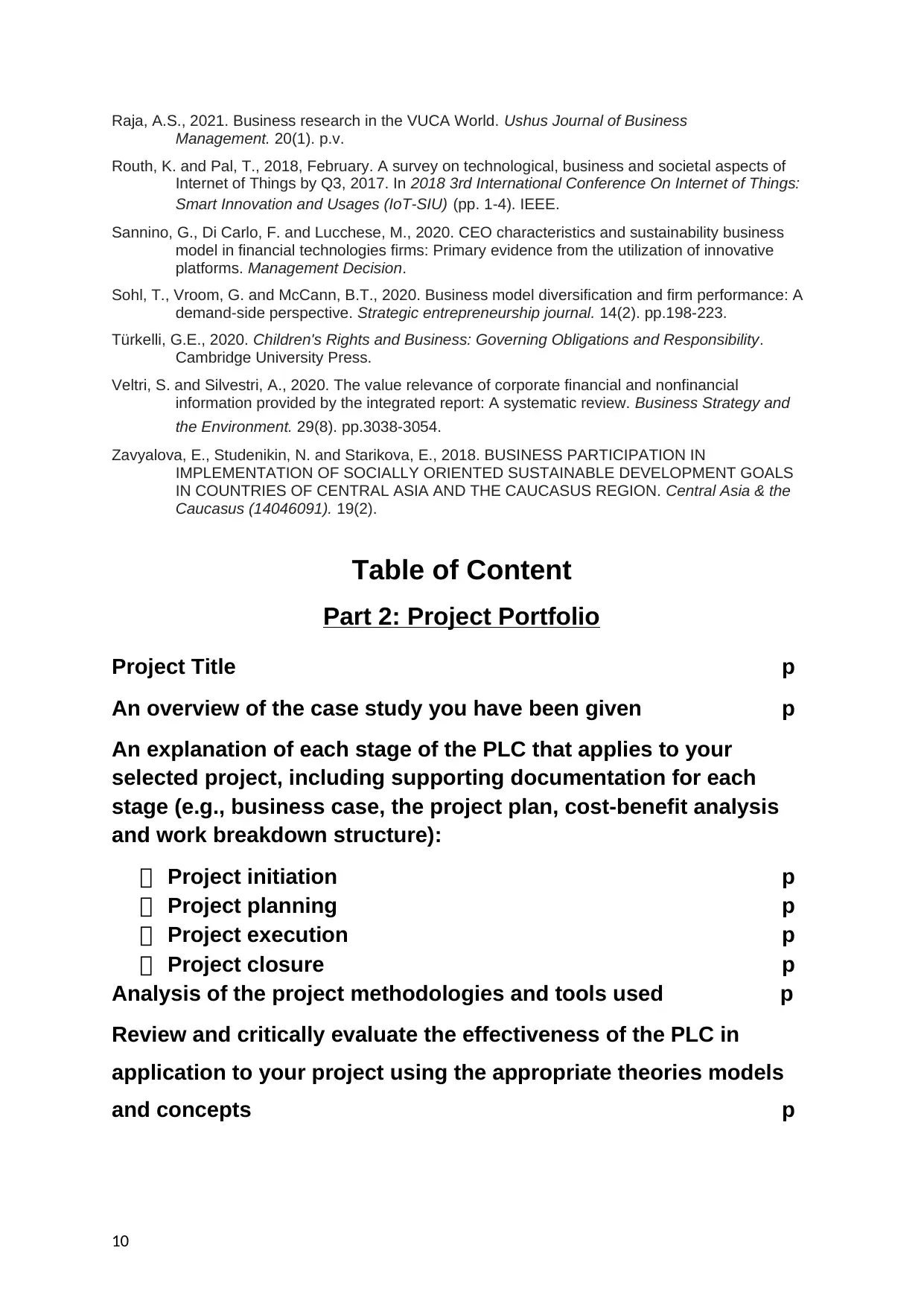
Raja, A.S., 2021. Business research in the VUCA World. Ushus Journal of Business
Management. 20(1). p.v.
Routh, K. and Pal, T., 2018, February. A survey on technological, business and societal aspects of
Internet of Things by Q3, 2017. In 2018 3rd International Conference On Internet of Things:
Smart Innovation and Usages (IoT-SIU) (pp. 1-4). IEEE.
Sannino, G., Di Carlo, F. and Lucchese, M., 2020. CEO characteristics and sustainability business
model in financial technologies firms: Primary evidence from the utilization of innovative
platforms. Management Decision.
Sohl, T., Vroom, G. and McCann, B.T., 2020. Business model diversification and firm performance: A
demand‐side perspective. Strategic entrepreneurship journal. 14(2). pp.198-223.
Türkelli, G.E., 2020. Children's Rights and Business: Governing Obligations and Responsibility.
Cambridge University Press.
Veltri, S. and Silvestri, A., 2020. The value relevance of corporate financial and nonfinancial
information provided by the integrated report: A systematic review. Business Strategy and
the Environment. 29(8). pp.3038-3054.
Zavyalova, E., Studenikin, N. and Starikova, E., 2018. BUSINESS PARTICIPATION IN
IMPLEMENTATION OF SOCIALLY ORIENTED SUSTAINABLE DEVELOPMENT GOALS
IN COUNTRIES OF CENTRAL ASIA AND THE CAUCASUS REGION. Central Asia & the
Caucasus (14046091). 19(2).
Table of Content
Part 2: Project Portfolio
Project Title p
An overview of the case study you have been given p
An explanation of each stage of the PLC that applies to your
selected project, including supporting documentation for each
stage (e.g., business case, the project plan, cost-benefit analysis
and work breakdown structure):
Project initiation p
Project planning p
Project execution p
Project closure p
Analysis of the project methodologies and tools used p
Review and critically evaluate the effectiveness of the PLC in
application to your project using the appropriate theories models
and concepts p
10
Management. 20(1). p.v.
Routh, K. and Pal, T., 2018, February. A survey on technological, business and societal aspects of
Internet of Things by Q3, 2017. In 2018 3rd International Conference On Internet of Things:
Smart Innovation and Usages (IoT-SIU) (pp. 1-4). IEEE.
Sannino, G., Di Carlo, F. and Lucchese, M., 2020. CEO characteristics and sustainability business
model in financial technologies firms: Primary evidence from the utilization of innovative
platforms. Management Decision.
Sohl, T., Vroom, G. and McCann, B.T., 2020. Business model diversification and firm performance: A
demand‐side perspective. Strategic entrepreneurship journal. 14(2). pp.198-223.
Türkelli, G.E., 2020. Children's Rights and Business: Governing Obligations and Responsibility.
Cambridge University Press.
Veltri, S. and Silvestri, A., 2020. The value relevance of corporate financial and nonfinancial
information provided by the integrated report: A systematic review. Business Strategy and
the Environment. 29(8). pp.3038-3054.
Zavyalova, E., Studenikin, N. and Starikova, E., 2018. BUSINESS PARTICIPATION IN
IMPLEMENTATION OF SOCIALLY ORIENTED SUSTAINABLE DEVELOPMENT GOALS
IN COUNTRIES OF CENTRAL ASIA AND THE CAUCASUS REGION. Central Asia & the
Caucasus (14046091). 19(2).
Table of Content
Part 2: Project Portfolio
Project Title p
An overview of the case study you have been given p
An explanation of each stage of the PLC that applies to your
selected project, including supporting documentation for each
stage (e.g., business case, the project plan, cost-benefit analysis
and work breakdown structure):
Project initiation p
Project planning p
Project execution p
Project closure p
Analysis of the project methodologies and tools used p
Review and critically evaluate the effectiveness of the PLC in
application to your project using the appropriate theories models
and concepts p
10
Paraphrase This Document
Need a fresh take? Get an instant paraphrase of this document with our AI Paraphraser
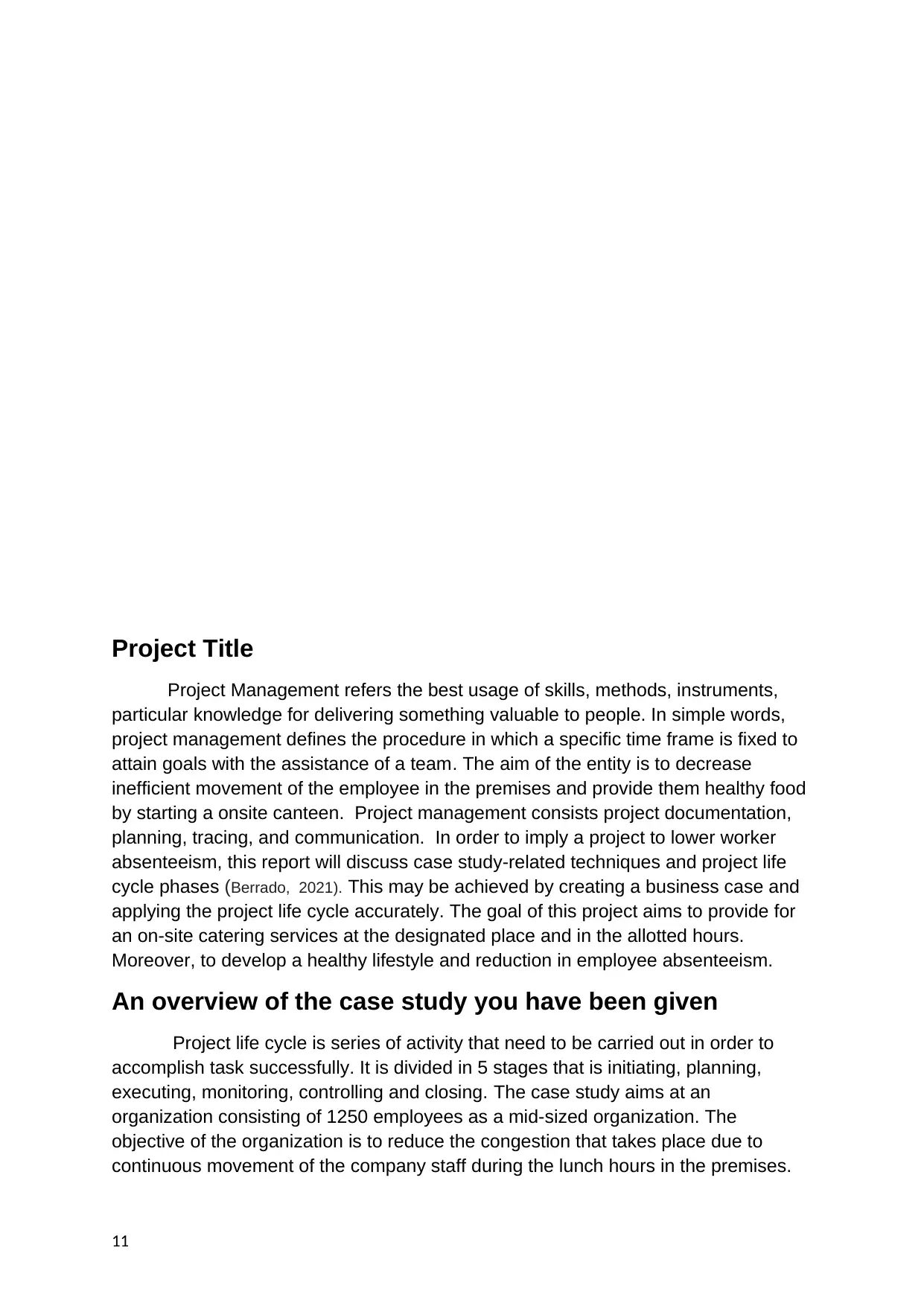
Project Title
Project Management refers the best usage of skills, methods, instruments,
particular knowledge for delivering something valuable to people. In simple words,
project management defines the procedure in which a specific time frame is fixed to
attain goals with the assistance of a team. The aim of the entity is to decrease
inefficient movement of the employee in the premises and provide them healthy food
by starting a onsite canteen. Project management consists project documentation,
planning, tracing, and communication. In order to imply a project to lower worker
absenteeism, this report will discuss case study-related techniques and project life
cycle phases (Berrado, 2021). This may be achieved by creating a business case and
applying the project life cycle accurately. The goal of this project aims to provide for
an on-site catering services at the designated place and in the allotted hours.
Moreover, to develop a healthy lifestyle and reduction in employee absenteeism.
An overview of the case study you have been given
Project life cycle is series of activity that need to be carried out in order to
accomplish task successfully. It is divided in 5 stages that is initiating, planning,
executing, monitoring, controlling and closing. The case study aims at an
organization consisting of 1250 employees as a mid-sized organization. The
objective of the organization is to reduce the congestion that takes place due to
continuous movement of the company staff during the lunch hours in the premises.
11
Project Management refers the best usage of skills, methods, instruments,
particular knowledge for delivering something valuable to people. In simple words,
project management defines the procedure in which a specific time frame is fixed to
attain goals with the assistance of a team. The aim of the entity is to decrease
inefficient movement of the employee in the premises and provide them healthy food
by starting a onsite canteen. Project management consists project documentation,
planning, tracing, and communication. In order to imply a project to lower worker
absenteeism, this report will discuss case study-related techniques and project life
cycle phases (Berrado, 2021). This may be achieved by creating a business case and
applying the project life cycle accurately. The goal of this project aims to provide for
an on-site catering services at the designated place and in the allotted hours.
Moreover, to develop a healthy lifestyle and reduction in employee absenteeism.
An overview of the case study you have been given
Project life cycle is series of activity that need to be carried out in order to
accomplish task successfully. It is divided in 5 stages that is initiating, planning,
executing, monitoring, controlling and closing. The case study aims at an
organization consisting of 1250 employees as a mid-sized organization. The
objective of the organization is to reduce the congestion that takes place due to
continuous movement of the company staff during the lunch hours in the premises.
11
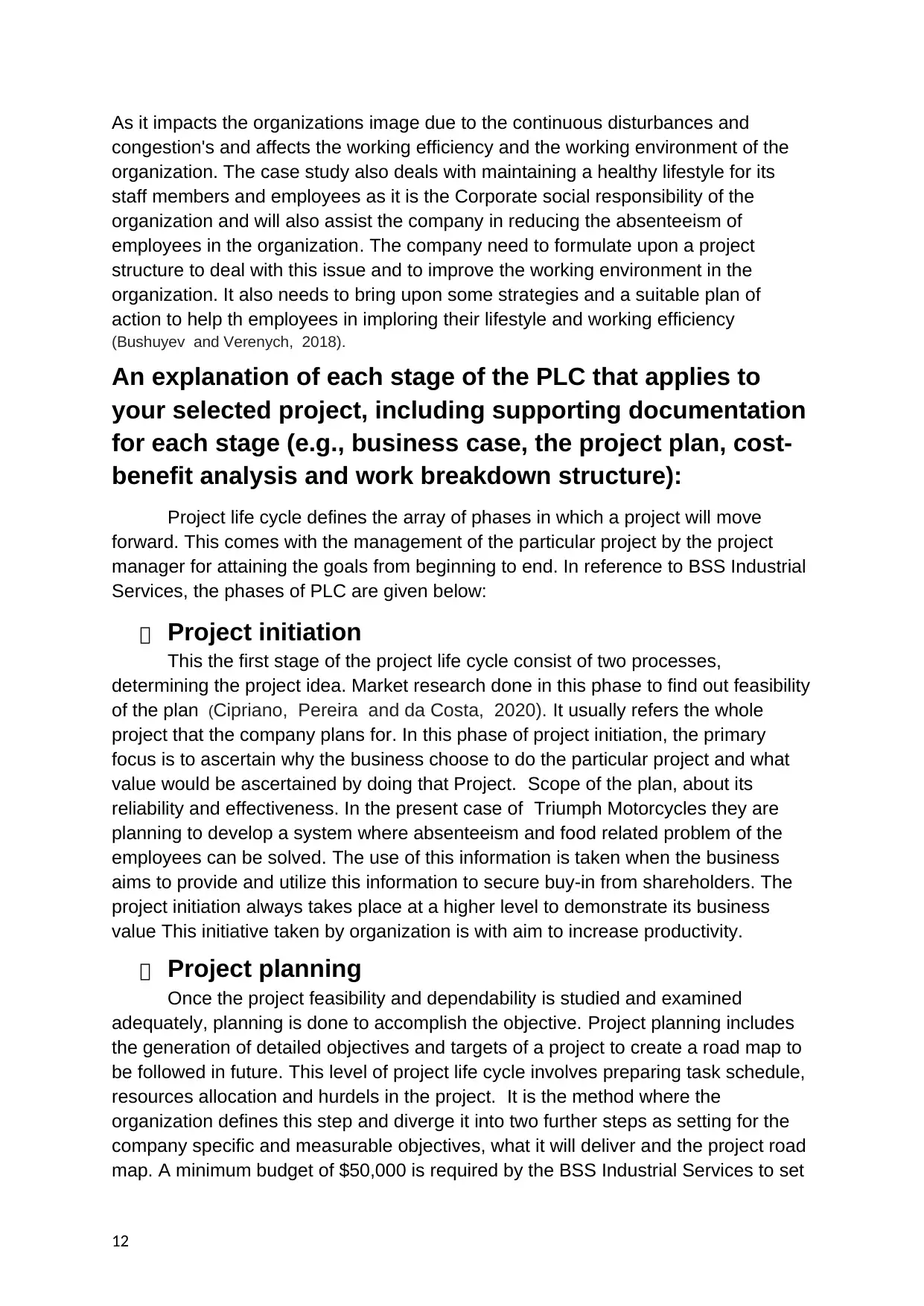
As it impacts the organizations image due to the continuous disturbances and
congestion's and affects the working efficiency and the working environment of the
organization. The case study also deals with maintaining a healthy lifestyle for its
staff members and employees as it is the Corporate social responsibility of the
organization and will also assist the company in reducing the absenteeism of
employees in the organization. The company need to formulate upon a project
structure to deal with this issue and to improve the working environment in the
organization. It also needs to bring upon some strategies and a suitable plan of
action to help th employees in imploring their lifestyle and working efficiency
(Bushuyev and Verenych, 2018).
An explanation of each stage of the PLC that applies to
your selected project, including supporting documentation
for each stage (e.g., business case, the project plan, cost-
benefit analysis and work breakdown structure):
Project life cycle defines the array of phases in which a project will move
forward. This comes with the management of the particular project by the project
manager for attaining the goals from beginning to end. In reference to BSS Industrial
Services, the phases of PLC are given below:
Project initiation
This the first stage of the project life cycle consist of two processes,
determining the project idea. Market research done in this phase to find out feasibility
of the plan (Cipriano, Pereira and da Costa, 2020). It usually refers the whole
project that the company plans for. In this phase of project initiation, the primary
focus is to ascertain why the business choose to do the particular project and what
value would be ascertained by doing that Project. Scope of the plan, about its
reliability and effectiveness. In the present case of Triumph Motorcycles they are
planning to develop a system where absenteeism and food related problem of the
employees can be solved. The use of this information is taken when the business
aims to provide and utilize this information to secure buy-in from shareholders. The
project initiation always takes place at a higher level to demonstrate its business
value This initiative taken by organization is with aim to increase productivity.
Project planning
Once the project feasibility and dependability is studied and examined
adequately, planning is done to accomplish the objective. Project planning includes
the generation of detailed objectives and targets of a project to create a road map to
be followed in future. This level of project life cycle involves preparing task schedule,
resources allocation and hurdels in the project. It is the method where the
organization defines this step and diverge it into two further steps as setting for the
company specific and measurable objectives, what it will deliver and the project road
map. A minimum budget of $50,000 is required by the BSS Industrial Services to set
12
congestion's and affects the working efficiency and the working environment of the
organization. The case study also deals with maintaining a healthy lifestyle for its
staff members and employees as it is the Corporate social responsibility of the
organization and will also assist the company in reducing the absenteeism of
employees in the organization. The company need to formulate upon a project
structure to deal with this issue and to improve the working environment in the
organization. It also needs to bring upon some strategies and a suitable plan of
action to help th employees in imploring their lifestyle and working efficiency
(Bushuyev and Verenych, 2018).
An explanation of each stage of the PLC that applies to
your selected project, including supporting documentation
for each stage (e.g., business case, the project plan, cost-
benefit analysis and work breakdown structure):
Project life cycle defines the array of phases in which a project will move
forward. This comes with the management of the particular project by the project
manager for attaining the goals from beginning to end. In reference to BSS Industrial
Services, the phases of PLC are given below:
Project initiation
This the first stage of the project life cycle consist of two processes,
determining the project idea. Market research done in this phase to find out feasibility
of the plan (Cipriano, Pereira and da Costa, 2020). It usually refers the whole
project that the company plans for. In this phase of project initiation, the primary
focus is to ascertain why the business choose to do the particular project and what
value would be ascertained by doing that Project. Scope of the plan, about its
reliability and effectiveness. In the present case of Triumph Motorcycles they are
planning to develop a system where absenteeism and food related problem of the
employees can be solved. The use of this information is taken when the business
aims to provide and utilize this information to secure buy-in from shareholders. The
project initiation always takes place at a higher level to demonstrate its business
value This initiative taken by organization is with aim to increase productivity.
Project planning
Once the project feasibility and dependability is studied and examined
adequately, planning is done to accomplish the objective. Project planning includes
the generation of detailed objectives and targets of a project to create a road map to
be followed in future. This level of project life cycle involves preparing task schedule,
resources allocation and hurdels in the project. It is the method where the
organization defines this step and diverge it into two further steps as setting for the
company specific and measurable objectives, what it will deliver and the project road
map. A minimum budget of $50,000 is required by the BSS Industrial Services to set
12
⊘ This is a preview!⊘
Do you want full access?
Subscribe today to unlock all pages.

Trusted by 1+ million students worldwide
1 out of 16
Related Documents
Your All-in-One AI-Powered Toolkit for Academic Success.
+13062052269
info@desklib.com
Available 24*7 on WhatsApp / Email
![[object Object]](/_next/static/media/star-bottom.7253800d.svg)
Unlock your academic potential
Copyright © 2020–2025 A2Z Services. All Rights Reserved. Developed and managed by ZUCOL.


